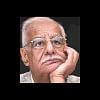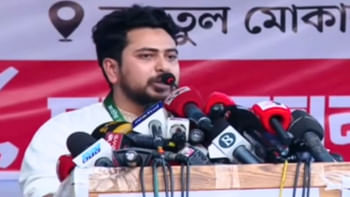It's a Mandir again

It is a Mandir again. The controversy over it comes to life whenever there are elections. The Babri Masjid was demolished in December, 1992. No doubt, the blame for the destruction is on the extremist Hindus, who did not even care for the Supreme Court's advice to let the status quo prevail. The controversy over it, however, was practically over.
The then prime minister Narasimha Rao connived the whole thing and promised to demolish the small temple which had come at the site in the wake of destruction. But he knew that the temple which had been built could not be destroyed because of the sentiments prevailing among the Hindus.
Today, the talk is whether there should be a park which the UP government wants or the museum that has the backing of the centre. There is no mention of rebuilding the mosque even at the distance from the temple, the compromise formula mentioned at one time. The Muslims seem to be afraid to revive the issue in the atmosphere of soft Hindutava that has come to prevail in the country.
Yet, the fact remains that the secular India cannot rub off the mark of shame from the forehead till the Muslims see a mosque in the vicinity of the temple. However, it is difficult to imagine this in the rule of Prime Minister Narendra Modi, who has been a RSS pracharak and who believes in its ideology.
India has lived with the Babri Masjid topic, first as an issue in the shape of controversy whether the Ram temple stood there once and then in the aftermath of the Masjid's demolition by some Hindu extremists. It was a dastardly blow to secularism which the country has claimed as its ethos even before independence. There were widespread riots in December 1992 and January 1993, fanatic Hindus leading mobs. The 1993 Mumbai bomb blasts were the Muslims' vengeance against the pulling down of the Masjid on December 6, 1992.
The Justice Liberhan Commission which has took 17 years to submit its report at least put a judicial seal on what was known through mouth, print or electronic media. The report, rather late in the day tried to reconstruct the sequence of events. It brought to the fore the lesser known facts that it was the RSS which had planned the destruction at Faizabad, some 10 kilometres from Ayodhya, the site of dispute and it was not an outpouring of frenzy at the spur of the moment. It was a well planned scheme. The RSS gave the roadmap, the BJP provided the necessary help to the Bajrang Dal, a militant wing of the RSS, to execute the demolition plan to the shame of the Indian nation.
L. K. Advani, Murli Manohar Joshi and the then UP Chief Minister Kalyan Singh were some of the witnesses. One picture which appeared in most newspapers was that of the gleeful Uma Bharti, then a BJP lightweight, riding the shoulders of Joshi. Some BJP leaders shed crocodile tears when they found that the common people throughout the country had reacted with anger and disapproval.
The most reprehensible aspect of the episode is that a small temple came up on the demolished site overnight. I recall asking Narasimha Rao certain questions about it. He had invited a few senior journalists to his residence to seek help to quell the riots. I asked him how the Centre had allowed a small temple to be built after the UP government had been dismissed and the central rule imposed.
Narasimha Rao explained that the central forces were flown from Delhi but could not land at Lucknow because the airport was engulfed with fog. I told him that he did not have to fly in troops from Delhi because there was already a surfeit of them at Ayodhya and around it. Narasimha Rao had no answer but told me emphatically that the temple would not be there "for long."
That was in December 1992. The temple is still there. Hundreds of pilgrims visit the place daily. The government has vast security arrangements to protect the small temple. No political party has ever raised the question of removing it from there. It can be said without contradiction that if the BJP government in UP was responsible for the demolition of the Masjid, the Congress was responsible for the small temple to come up.
The Muslim psyche is hurt. The Liberhan Commission's findings have put a balm which should have healed the wounds of Muslims. On the other hand, the government has not taken any action against leaders like Shiv Sena Chief Bal Thackrey, although the Justice Srikrishna Commission named him responsible for the Mumbai riots in December 1992-January 1993. Some BJP leaders mentioned by the Liberhan Commission for riots in the wake of the demolition are still in the forefront of the party.
The Congress did not initiate any action against those who took the law in their hands during the emergency (1975-77) and committed the worst type of excesses. In fact, the party punished those who brought the perpetrators to justice. But there was a murder of values and institutions. Even the fundamental rights were suspended and the press gagged. The then Attorney General proudly told the judges that if some policemen were to shoot any one of them dead, they would not be able to haul them up.
My worry is that without the awareness of what is right and a desire to act according to what is right, there may be no realisation of what is wrong. Over the years, the dividing line between right and wrong, moral and immoral, has ceased to exist. The tug of conscience, which was once there, has evaporated.
The Liberhan Commission provided an opportunity to set things right. The guilty, however high in office or politics, must be punished. Democracy is nothing but the independence of institutions. They must be restored to the position that the constitution has given them. The demolition of the Babri Masjid was a consequence of bigotry that took over most people in the north at that time and still lingers at some places and in some organisations. The idea of India cannot exist for long without pluralism. The institutions have to rise to the occasion.
The writer is an eminent Indian columnist.

 For all latest news, follow The Daily Star's Google News channel.
For all latest news, follow The Daily Star's Google News channel. 



Comments